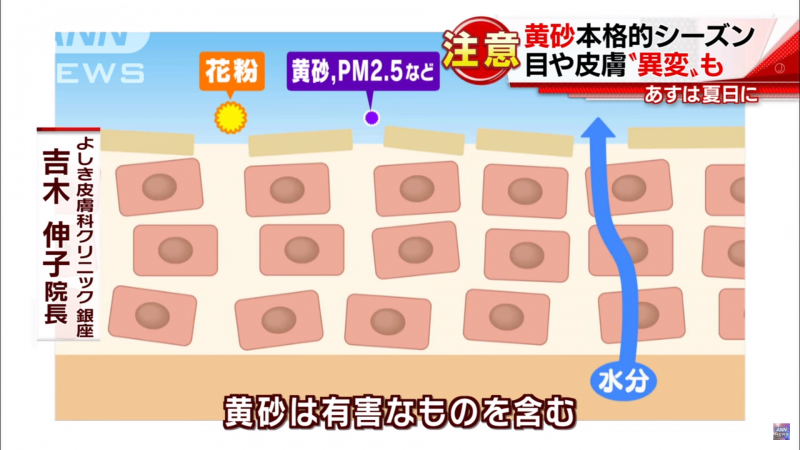
Beware the Yellow Dust. Image edited by Kevin Rothrock.
Yellow dust [1], or kosa (黄砂), is a traditional harbinger of spring in East Asia. Powerful spring westerly winds pick up sand, dust, and sediment from arid regions of the Asian continent, including the Gobi Desert [2] in Mongolia and the Loess Plateau [3] in China.
【25日にかけて黄砂とPM2.5に要注意】全国的に飛散が継続する見込み。特に呼吸器系疾患の方は外出を控えたり、マスク等で自己防衛を。気象庁が黄砂に関する全般気象情報発表。屋外では黄砂の付着への影響や視程悪化による交通障害に要注意 pic.twitter.com/QYlvmoh8Ax [4]
— 大竹(気象予報士) (@ohtakepapa) April 24, 2016 [5]
There is a “Yellow Sand” and PM 2.5 warning for April 25, 2016. People experiencing respiratory illness should avoid going outdoors, or should take precautions by wearing a mask. The Japan Meteorological Agency has issued a general alert for Yellow Sand. Yellow Sand particulate has made visibility poor, so please be aware of driving conditions.
The dust is transported throughout northeast Asia, including to the Korean Peninsula [6], Japan, and even the Russian Far East.
In Japan, yellow dust traditionally announces its arrival by leaving cars, windows, and clothes hung out to dry coated with a noticeable layer of grime. The wind-blown dust also creates a blue or yellowish haze that can obstruct the sun. Efforts to reduce particulate emissions in Japan over the last fifty years, combined with an ongoing trend that sees manufacturing (and the polluting power generation needed to power it) offshored to China, has resulted in very high air quality in Japan, even in urban areas like Tokyo.
The arrival of Yellow Sand each spring is unwelcome, not only because of hazy skies and a fine film of grit over everything, but also because the dust can also cause severe allergic reactions that ruin spring for many people.
今日も花粉と黄砂がヤバイです…😱 pic.twitter.com/zd1Yhxe0nP [7]
— 執事ஆ【ちゃっこௐ】 (@chacko0329) April 15, 2016 [8]
The combination of pollen and Yellow Sand today is awful!
窓汚いなーと思ってウォッシャーしたら、黄色かったΣ(□`;)
黄砂コノヤロウ( ・᷄ὢ・᷅ ) pic.twitter.com/aWsb1VQ7ca [9]— 忍@あんマルとろ (@sinobu_s4) April 15, 2016 [10]
My windshield was dirty so I thought I would try to use the windshield wipers to get the dust off. But the Yellow Sand is everywhere! You damned Yellow Sand!
This news report captures the images—and angst—of the yellow sand phenomenon in Japan:
According to the above report, Yellow Sand is smaller than a grain of pollen, and typically contains many pollutants. These microparticles enter the skin through the pores and end up under the skin, causing inflammation.

“Yellow Sand contains many pollutants.” Image is cross-section of epidermis. Pollen (orange) and Yellow Sand, PM 2.5 microparticles (purple) enter the skin through the pores. Image from ANN official YouTube channel [11].
Twitter users are busy this month swapping tips on how to deal with skin irritation caused by the current wave of Yellow Sand:
ここ数日どうも皮膚の調子が良くないと思ったら、黄砂飛んで来てんのか
— パラダイスさん (@paradisemaker) April 23, 2016 [12]
My skin has been in terrible condition for the past few days. I wonder if it's because of the arrival of Yellow Sand?
@ann1951809 [13]
こんにちは😊
病院、行き帰りだけでも疲れたり…大丈夫ですか? 花粉も何だか黄砂か排気ガスかいっしょになってるように思います。もう、しばらく目や鼻や皮膚や違和感があるだろうけど保ちこたえましょうね😁
広島はお天気が良くて暑いです。のんびり過ごします🍀— のりこ (@6RGevzrGPZ9i1yy) April 14, 2016 [14]
[…] I think (getting sick) must be a combination of pollen allergies, Yellow Sand and pollution from automobiles. It seems like that for the next while, eyes, nose, skin and everything is going to be irritated, so let's take care. […]
車の排気ガスや工業地帯からの煙に含まれる物質には「シミ」を作らせる成分が
見つかっています。また、黄砂やPM2,5も皮膚呼吸を妨げアレルギーや気管支炎などの
原因になるのです。#beautyjp [15]— ビューティーハックス24 (@beautyhacks24) April 9, 2016 [16]
There's some research that liver spots (シミ, shimi) and other skin blotches are caused by particulate from automobile exhaust, industrial emissions and so on. As well, Yellow Sand and PM 2.5 particles also contribute to the problem by causing allergic reactions.
While pollution may be a more recent concern, Yellow Sand has long affected Japan and Japanese culture. In fact, there's even an obscure word that can be used to describe the arrival of the Yellow Sand: tsuchiburu (霾, つちぶる).

Tsuchifuru. Screencap from ANN official YouTube channel [11].
While not a common word (and likely unknown to most Japanese television viewers), tsuchiburu means the “descent of Yellow Sand” and combines the characters for ‘rain’ (雨, あめ) and ‘raccoon dog,’ (狸, タヌキ), an animal known in Japanese mythology for reveling in dirt.